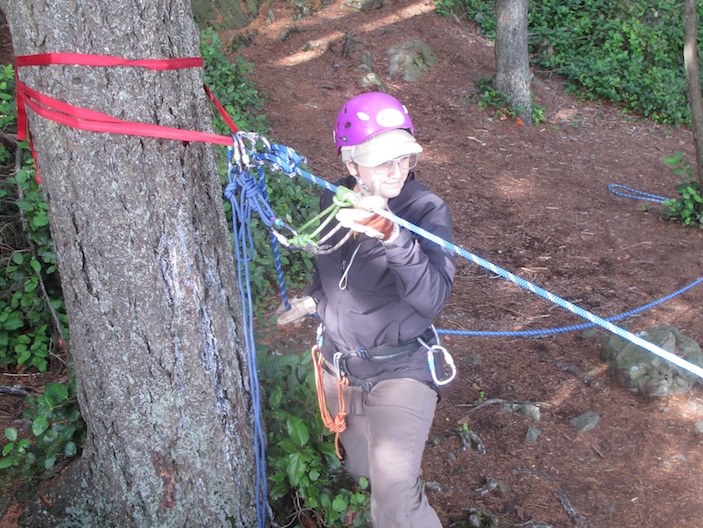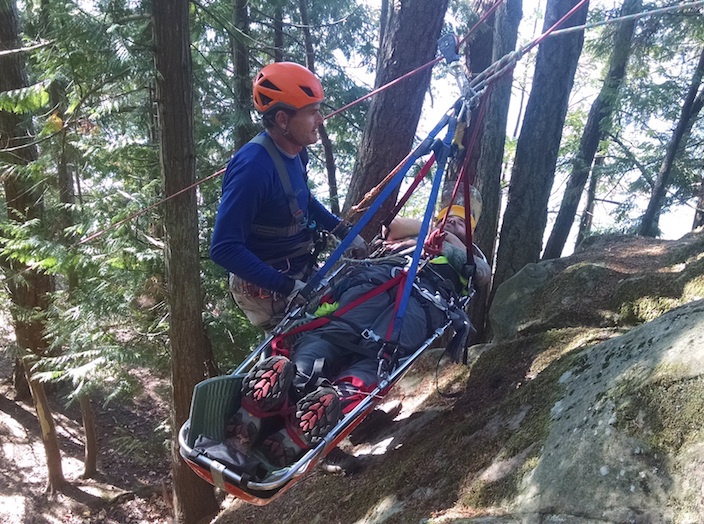Technical Rope Rescue Level I - Operations Overview
An attendant in the upper litter position descends on a high angle lowering system.
A car careens off the highway, dropping over a steep embankment and comes to a stop nearly two hundred feet down the rocky forty-five degree slope. Two of the car's occupants are seriously injured and need to be evacuated immediately.
The preceding scenario is one that first responders regularly encounter throughout the United States. Fire departments, paramedics and mountain rescue units often have locations in their service areas where steep or high-angle terrain exists. Those teams with the highest level of rope rescue training are able to extract these difficult patients in a timely manner without putting themselves or their teammates in harms way for an undue amount of time.
The American Alpine Institute Operations Level Rope Rescue course addresses the needs of first responders in low-angle and high-angle terrain while also providing the baseline skills required to assist Rope Rescue Technicians with complex systems. The course meets the standards for operations dictated by NFPA 1670 while also addressing the standards set forth in NFPA 1006 and 1983.
Individuals and organizations trained at the NFPA operations level are capable of:
Site Control - preventing anyone else from becoming a victim through scene management.
Incident Identification - able to identify whether an accident site will require an operations level or a technician level response.
Able to perform simple patient rescues on low and high-angle terrain.
Able to perform operations that require the lowering and raising of a litter and/or a litter attendant.
Rope Rescue Operations Certificate
Individuals who complete the American Alpine Institute Operations course will receive a certificate of completion for Rope Rescue Level I: Operations.
Technical Rope Rescue Comprehensive
Front country rescue personnel often don't need anything beyond an Operations or Technician course. However, those who wish to operate in the backcountry should consider additional training.
The American Alpine Institute Operations Course is the first of a 14-day four-part rescue comprehensive series. The Level I Operations Course lays the groundwork. The Level II Technician Course builds on that groundwork. The Self-Rescue for Climbers program adds personal and companion rescue to your skillset. And then finally, the Advanced Mountain Rescue program takes the skills learned in the Operations, Technician, and Self-Rescue courses and builds on them with high-end mountain rescue skills.
A rescuer may choose to take one, two, three or all four parts together. Or the rescuer may choose to break up the courses into bite-sized chunks.
To learn more about the Technical Rope Rescue Comprehensive program, click here .
Technical Rope Rescue Level I - Operations Curriculum Students will demonstrate proficiency in team-rescue at the NFPA operations level on a variety of steep and high-angle terrain types.
A team is lowered down to a victim in a steep angle setting. Jason Martin
Curriculum Highlights
Hauling Systems - 3:1, 6:1 and 9:1
Pulley Systems - simple, compound and complex
Lowering Systems - with a break rack and scarab
Anchor Systems
Lowering Systems with a Litter
Use of a Guiding Line
Patent Packaging - with and without a harness
Specialized Rescue Equipment - including discussions of Class I-III harnesses, chest harnesses, rigging plates, pulleys, swivels, edge protection, and tripods
Improvised Rescue Equipment - waist and chest harnesses, high points, and improvised anchors
Rope Climbing Techniques
Belays - tandem prusik and mechanical belays
Scene Management - command structure
Helicopter Operations
Physics of Rescue Systems on Anchors and on Equipment
Rappelling Techniques
Knots - figure-eight family, overhand, double-overhand-on-a-bite, bowline, double bowline, long-tail bowline, high tension tie-off, wrap-three-pull-two, and wrap-two-pull-one
Bends - double-fisherman's, water bend, double sheet bend, frost bend
Hitches - prusik, and munter
Load Releasable Hitches - radium-release
Required Text
Technical Rescue Riggers Guide by Rick Lipke
This text may be purchased at the American Alpine Institute Shop or online.
Prerequisites
Participants should have a good level of fitness. Baseline knowledge of knots and hitches can be helpful, but is not required.
Technical Rope Rescue Level I - Operations Dates & Details Washington
April 13 - April 16, 2024
Sept 28 - Oct 01, 2024
Nov 09 - Nov 12, 2024
Since this program is focused on the concept of team rescue , the training scenarios require a group of rescuers to perform all the necessary tasks. So with that in mind, a minimum of 5 students are required to be enrolled in order for this program to run.
A Note about the Operations vs. Technician Level
American Alpine Institute Rope Rescue Operations courses are often followed immediately by NFPA compliant Technician Level courses. If you would like to take both courses in a row, please inquire with the American Alpine Institute office.
Combined Operations and Technician Course Fee: $1795
If one were to take our Operations course and Technician course as separate, stand-alone programs, they would be 4 and 5 days long (repsectively). However, we run them in sequence so there is an overlap of two days and the total program length of taking them combined is 7 days:
Operations Course: Days 1 - 4
Technician Course: Days 3 - 7
Inclusions and Exclusions
Included with the tuition are instructors, group equipment (both rescue and climbing), classroom location, permit fees, and transportation to and from field program locations.
Excluded are front-country lodging, personal climbing equipment, transportation to the classroom, food, trip insurance, camping equipment, and guide gratuities.
Private Programming
Any portion of this program, either the complete program or individual pieces of the program may be provided privately at any appropriate location. Please call the American Alpine Institute office for a quote.
Technical Rope Rescue Level I - Operations Organizations & Credentials There are several organizations that oversee rescue standards in the United States. They all have different missions, but many of the core rope rescue components are the same.
Following is a list of the organizations that develop rope rescue standards. AAI's rescue programs align with these organizations and the standards they set fourth.
Mountain Rescue Association (MRA)
The MRA oversees a patchwork of volunteer and professional rescue teams in the United States and Canada. They develop standards and accredit local mountain rescue units in three disciplines: high-angle rescue, search, and snow.
National Fire Protection Association (NFPA)
The NFPA is an organization devoted to "eliminating death, injury, property and economic loss due to fire, electrical and related hazards." To do this, the organization develops codes and standards for individuals operating within the fire service. These standards include operating practices for technical rescue teams.
American Mountain Guides Association (AMGA)
The AMGA oversees technical mountain guides in the United States. The organization credentials instructors and guides, while also accrediting guide services. The AMGA recognizes three disciplines with several levels of certification. The disciplines are Rock, Alpine and Ski. Each discipline has rescue components on which instructors and guides are tested.
International Technical Rescue Association (ITRA)
The ITRA is an organization that provides global recognition of technical rescue practitioners and instructors, across a wide range of rescue disciplines, including swiftwater, rope, boat, confined space and animal rescue.
Why should I complete my rescue training with the American Alpine Institute?
There are three primary reasons why you should consider AAI:
1) Experience: All AAI Instructors are also mountain guides with extensive and diverse experience in high-angle terrain. They work with ropes every day and constantly solve new technical problems. Additionally, all AAI rope rescue instructors have technical training from the American Mountain Guides Association.
2) Continuing Education: Members of the AAI Technical Rope Rescue Instructor Team get regular updates and continuing education in technical rescue. These updates come from a wide array of conferences and meetings. One or two Instructor Team members attend a given meeting and then bring what they learn back to the rest of the instructors, as well as to AAI students. The meetings and conferences attended on a regular basis include, but are not limited to, the International Technical Rescue Symposium, the International Commission on Alpine Rescue, the Mountain Rescue Association Annual Meeting, the Wilderness Risk Management Conference, and the American Mountain Guides Association.
3) Commitment to International Standards: The American Alpine Institute is a founding member of the International Technical Rescue Association (ITRA). AAI's programs are overseen by ITRA Level III Instructors, the highest level instructor recognized.
Technical Rope Rescue Level I - Operations Related Courses
Program Finder
By Location
United States - Alaska
United States - Washington
United States - California
United States - Nevada
United States - Colorado
United States - Utah
Canada - British Columbia
South America - Argentina
South America - Bolivia
South America - Ecuador
South America - Patagonia
South America - Peru
Europe - Alps and Caucasus
Asia - Nepal and Tibet
Asia - Laos, Thailand, & Vietnam
Asia - China
Asia - Japan
Africa - Tanzania
Pacific and Antarctica
By Program Type
Instructional Courses
Group Summit Climbs
Expeditions
Skills Expeditions
Private Guided Programs
Treks, Tours, & Backpacking
Corporate Outings & Services
Government & Military
By Activity
Rock Climbing
Ice Climbing
Alpine Climbing
High-Altitude Climbing
Trekking and Backpacking
Skiing & Snowboarding
Guide Training & Rescue
Avalanche Training
Departure Month
Difficulty Level
Beginner
Moderate
Intermediate
Advanced
Very Advanced
x




